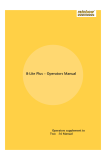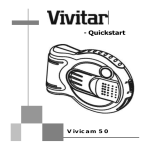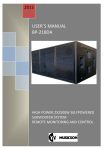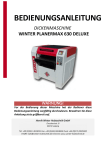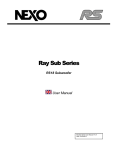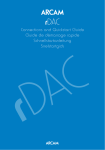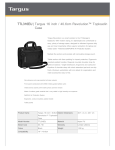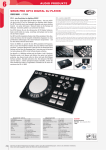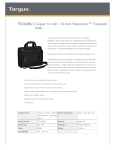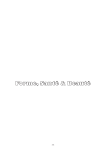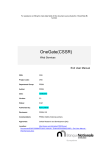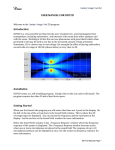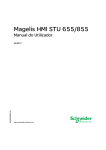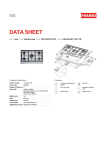Download 15" Plus – Operators Manual
Transcript
15" Plus – Operators Manual Operatos supplemet to Two-16 manual Congratulations on choosing a Rainbow Colour Changers product! We thank you for your custom. Please note that this product has been designed and made with total quality to ensure excellent performance and best meet your expectations and requirements. It is essential to know the information and comply with the instructions given in this manual in order to ensure the fitting is installed, used and serviced correctly and safely. Carefully read this instruction manual in its entirety and keep it safe for future reference! Please hand this manual over if you sell or give this product to somebody else. General Rainbow Colour Changers products are intended for professional use and should only be used by qualified personnel or under their supervision. Follow all cautions and warnings indicated on the unit. After unpacking this product, please check if the device is intact. If this is not the case, please contact the support service. Rainbow Colour Changers An der Talle 26-28 D-33102 Paderborn, Germany Phone: +49 (0)52 51/14 092-28 Fax: +49 (0)52 51/14 092-90 [email protected] Installation Make sure all parts for fixing the colour changer are correct. Make sure the fixture is stable before positioning the Colour Changer. Do not fix this device on or near flammable surfaces. Usage This product is designed for indoor use only. For the fitting to operate well and reliably, it should not be used in humid environments. The ambient temperature should not exceed 40°C (104°F) or fall below 0°C (32°F). Avoid any liquids or metallic items entering the unit. Ensure adequate ventilation and do not block or cover any ventilation slots in the device – they guarantee the reliable functioning of the unit and protect it against overheating. The scroller may only be used in its standard position, which is +/- 60° from horizontal. The colour changer may only be put into operation with original Rainbow Colour Changer power supply units (PSU). Check that the mains frequency and voltage correspond to those for which the PSU is designed as given on the surface label of the PSU. Refer to the manual about the max. amount of scrollers to be connected Maintenance All service work should be exclusively performed by qualified personnel. Do not dismantle the scroller or modify it yourself. Before starting any maintenance work or cleaning the scroller, remove the power from the PSU. The surface of the device may heat up due to the luminaire used. Please let the scroller cool down before touching it. Rainbow Colour Changers GmbH disclaims all liability for damage to the fitting or to other property or persons deriving from installation, use and maintenance that have not been carried out in conformity with this instructions manual, which must always accompany the fitting. Rainbow Colour Changers GmbH reserves the right to modify the characteristics stated in this instructions manual at any time and without prior notice. SETTING THE HOOKWING POSITIONS - Adaptor Mk.II The 15" Plus Colour Changer for Fresnel Luminaires is supplied with a universal adaptor which allows fitting to a variety of different lanterns. The four hookwings can be mounted on the plate in either diagonally or the 0,90,180,270o positions for pole operated or manual lamps. The positions are set by loosening the retaining screws holding the hookwings and sliding until the correct number of holes are visible in the slot. Where the configuration is to be changed from x to +, the hookwings can be slid off and easily repositioned. The table below and over the page gives a full summary of the of luminaires and their Barndoor slide-in dimensions. 1 2 3 4 5 6 7 8 9 10 Fitting Positions: Posn Ref: Dims: To Fit: Luminaire: Hook angle Studio 5kW Compact 4kW MSR Pollux 5kW Pollux 2.5/5kW Vega 10kW Sirio 2.5, 4, 6 kW HMI 5kW Studio SH50S, SP50 2x2500W SH25S, SP25S 5kW Studio Leonardo 4kW HMI x 1 412 ARRI 2 402 Strand ADB 3 396 Desisti 4 5 6 7 382 370 355 343 Lee Sachtler Arri ADB 9 10 322 313 15" Plus Manual Strand Desisti x 'Twister' Director 2025H, 3750H, 1225D 2550D Studio 2kW Junior 5kW Compact 2.5kW MSR 2kW Studio SH20S, SHF20S, SP20, SPF20 5kW Baby CH50S,CP50 2x1250W Fresnel SH12S, SP12S Studio 2kW 5 x + x x x x + + + + x x + + + + x Revision 1 - Printed April 10, 1997 PREPARING THE GEL STRINGS The manufacture of a good gel string is important for the smooth and quiet running of the colour changer. Rainbow Colour Changers offer a rapid scroll making service please contact your local dealer for this facility. If you are manufacturing your own gel strings, they should be cut as follows: Good quality colour scrolls ensure the smooth and quiet running of the colour changers. Frames should be connected together with Special High Temperature Tape connected to the front side of the filter. Tape can be ordered from Rainbow Colour Changers. Ensure that sides are parallel and the bottom edge is straight. The frames should be taped edge to edge, avoiding overlapping the colours. We suggest that you avoid mixing polyester and polycarbonate gels because they expand at different rates and will cause uneven travel. THERMAL MANAGEMENT The 15" Rainbow is fitted with a tangential fan for efficient cooling across the full width of the filter frame. The fan can be controlled from either the HIGH/ LOW switch or the proportional fan control on the PlusCards. The filter life is dependent on many factors such as the lamp, colour type and whether heatshield is fitted: 15" Plus Manual 6 Revision 1 - Printed April 10, 1997 FITTING THE GEL STRING The Gel String is fitted from the front of the unit. This allows the RCC to be loaded without removing from the unit, or laid on the bench. Access is easy by removing the interchangeable front housing. The PlusCard has position and speed control for simple loading without the need for a console or control signal. The gel string is fitted and calibrated using the PlusCard as follows: 1. 2. 3. The 15" Plus RCC should be powered up. Remove front cover by pressing side catches in and slide the front housing up. Set Mode switch to F, and the Frames to 2.The rolls will position themselves to the zero position. Once the rolls have stopped, set the Frames switch to 0. 4. The 15" Rainbow is trimmable between two and sixteen colours using the Range Trim 15 turn potentiometer on the front of the analog pcb. The RCC is factory trimmed to 11 colours. 5.. Lay the colour across the red roller and tape the leading edge of frame zero to the Blue roller. Line up the edge of the filter with the marked line on the scroll. 6. Holding the filter loosely, set the Mode switch to D. The frames switch controls the loading speed (0=Stop to 3= Fast). Set the Frames setting to 1 and the filter will load onto the blue roll, using the red roll as a guide. Regulate the speed using the Frame selector. At the end, one of the following will occur: If the unit is under trimmed: The RCC will stop at full before the filter has been fully loaded on the blue roll. Turn the RANGE TRIM potentiometer clockwise to wind the extra filter onto the blue roll. If the unit is over trimmed: The RCC will try to wind on more filter than there is on the roll. At the last frame, stop the RCC by setting the Frame selector to 0. Turn the Range trim anti-clockwise to pay out more filter and then use the Frame control to wind the filter onto the roll. Repeat until the last frame is wound on to the roll. 7. Apply a small amount of tension to the scroll. This is performed by pushing and turning the gold inner knob anticlockwise whilst holding the Black outer knob. 8. Move the scroll back to the zero point by setting the Mode to F and controlling the speed on the Frames switch. 9. Set the zero position, by pushing the Gold and Black knobs together and positioning the seam between Frames 0 and 1 to align to the outer edge of the roll. 10. Set the scroll tension further by pushing the gold inner knob anticlockwise whilst holding the Black outer knob. The correct scroll tension varies with different scroll lengths and it is best to recheck scroll tension at 50% when the scroller has been set. (This can be done by setting the Mode to E, the address to 050, and controlling the speed on the frames selector). Approximately 6 turns will give the correct tension for a 11 colour 15" scroll. ......cont 15" Plus Manual 7 Revision 1 - Printed April 10, 1997 FITTING THE GEL STRING .....continued 11. Move the scroll back to the full point by setting the Mode to D and controlling the speed on the Frames switch. 12. Use the Range Trim potentiometer to accurately set the end position of the scroll. This position is correct when the final seam is aligned with the outer edge of the Rainbow. 13. Set the Mode/Frames switch on the PlusCard to the required setting The scroll is now correctly installed with a scroll and trimmed. From experience, we suggest that you: i ii iii Run the colour changers end to end a few times. This allows the filter to find its natural position on the spindle. It will also show any noise problems due to badly made scrolls; Where many units are to run together, run the colour changers to 95% and confirm alignment of all units. Retrim where necessary ; Check the scroll tension at 50% control input; (Mode=E, Addr.=050). FITTING A BARNDOOR TO THE FRONT OF THE UNIT The removable front panel is fitted with four wheels for fitting a rotatable barndoor. The barndoor is fitted by rotating the top left wheel on its bracket and inserting the barndoor as below: Step 1 Step 2 Step 3 Step 4 Loosen Screw A until the bracket rotates The screw is captive and will not come out Rotate the bracket Insert the barndoor so that it freely rotates within the other three wheels Rotate the bracket back to its original position, and retighten Screw A 15" Plus Manual 8 Revision 1 - Printed April 10, 1997 CONNECTION AND CABLING The Colour changers can be operated from either and analog or DMX digital signal. The interconnecting cables which connect the Rainbows carry both power and data and should be rated for both. The connection of the units is as follows: POWERING THE UNITS Rainbow Colour Changers are powered by a 24V DC supply which is derived from a central power supply. This can either be a Maxi combined Power Supply/Splitter or separate power supply/splitter combination. Traditionally the PSUs have been rated in terms of the number of 8" RCC units which can be driven from one supply. This does not apply to the larger Rainbows which take approximately twice the current of the 8" colour changer. One 15" RCC counts as two units. + = So a 24 unit PSU or a Maxi PSU/Splitter can supply: 24 x ,or 12 x , or 14 x and 5 x . This also applies to the other scrollers as follows: 8" TWO-16 8" ALFRESCO 15" PLUS 8-LITE 20" INCH Light Curtain 15" Plus Manual 1 UNIT 1.5 UNITS 2 UNITS 2 UNITS 2 UNITS 2 UNITS 9 Revision 1 - Printed April 10, 1997 MODE 0 - STANDARD OPERATION Mode 0 - Standard Operation / Continuous Gel Position With Mode 0 selected and the Frame switch set to zero, the Rainbow operates as a standard DMX decoder, with proportional control. The user selects the DMX address for each individual colour changer using the three address selectors . The gel speed is set by the speed of control input and the Rainbow type. The fan is controlled by the standard HI / LO fan speed switch on the rear of the Rainbow. In modes 0-2, the internal tangential fan is controlled from the HI/ LO switch on the front panel of the pcb housing. Mode 0 - Standard Operation / Frame by Frame Mode Frame by Frame Control can be selected in this mode. Set the Frame rotary switch to the number of frames excluding Frame 0. See Page 17 for further instructions. 15" Plus Manual 10 Revision 1 - Printed April 10, 1997 MODES 1 & 2 - STANDARD MODE,PRESET GEL SPEEDS Modes 1 & 2 - Standard Control with Preset Gel Speeds In many cases, standard Rainbow features may be required, but high speed end to end changes are not necessary. In Modes 1 & 2, the PlusCard can be set to limit the maximum gel speed for longer gel life, even lower noise levels, and smoother crossfades. The speeds of the fans are still controlled by the HI/LO switch on the rear of the Rainbow. Mode 1 - Medium Speed Mode 2 - Slow Speed The crossfades are calculated using 12 bit counters - resulting in smoother crossfades, especially critical on the longer gel string fitted to the 15" Plus Frame by Frame Mode Frame by Frame Control can be selected in this mode. Set the Frame rotary switch to the number of frames excluding Frame 0. See Page 17 for further instructions. 15" Plus Manual 11 Revision 1 - Printed April 10, 1997 MODES 3 TO 5 - 2 CHANNEL CONTROL Modes 3-5 - Fan Control with preset Gel Speeds Modes 3 - 5 allow an operator to control the filter position and the fan speed of individual Rainbows in the rig with two sequential DMX addresses. Three preset maximum gel speeds are available for up to 12 bit resolution on slow crossfades (limited by console fade time): Mode 3 Address nnn nnn+1 Gel speed = = = Resolution = Gel Position Fan Speed Max speed (Dependent on model / no of Frames 15" RCC = 4.5s) As DMX (8 Bit) Mode 4 Address nn nn+1 Gel speed Resolution = = = = Gel Position Fan Speed Medium Up to 12 bit Mode 5 Address nn nn+1 Gel speed Resolution = = = = Gel Position Fan Speed Slow Up to 12 bit Address Position Fan Speed 21 21 22 23 23 24 25 25 26 Frame by Frame Mode Frame by Frame Control can be selected in this mode. Set the Frame rotary switch to the number of frames excluding Frame 0. 15" Plus Manual 12 Revision 1 - Printed April 10, 1997 MODE 6 - 'FAST' THREE CHANNEL OPERATION Mode 6 - Fast Control of Position, Gel and Fan Speed The fast control gives standard operation of the colour changer, but with the Gel speed controlled by DMX address 510 and the Fan speed controlled by DMX address 511. This is designed for where the lighting operator needs overall control of the fans and scrolls, but without the need to individually select each Colour Changer. For example, in rehearsal where the designer is moving quickly between states, the gel speed of the complete rig can be easily limited on a single fader to avoid all the scrollers jumping from state to state. In the same way, the fan speeds may be controlled for when total silence is required during a section of a show. DMX Address 510 @ 00 DMX Address 511 @ 00 Max Speed FF Slowest Fade Fans Full On FF Fans Off The gel speed control follows an exponential curve, allowing fine tuning of cues at faster times, but allowing very long stepless cues to be executed. For control consoles whose patch is limited to less than 512 dimmers, an internal jumper can be set such that the speed and fan addresses are 191 / 192. 'Fast' Frame-by-Frame Control Fast control setting can be used in frame-by-frame mode by setting the Frame selector to the number of frames in the gel string. Fan and Gel Speed control are as above. 15" Plus Manual 13 Revision 1 - Printed April 10, 1997 MODE 7 - THREE CHANNEL CONTROL Mode 7 - Control of Position / Fan / Gel Speed Where total flexibility is required, the Rainbow can be controlled using three control channels. Lighting cues can be plotted with colour information, limits on the maximum speed of gel movement and fan speeds. Each Rainbow uses three independent DMX addresses for control of these features: For example: Address Position Gel Speed Fan speed 21 21 22 23 24 24 25 26 27 27 28 29 3 Channel Control with Frame-by-Frame operation As with other modes, Frame by Frame operation is selected by setting the frame length (No. of Frames - 1) on the Frame switch on the rear of the Rainbow. All of the other features available with 3 Control are possible, with only full frames of colour displayed. 15" Plus Manual 14 Revision 1 - Printed April 10, 1997 MODE 8 - CONTINUOUS OPERATION MODE Mode 8 - Continous Fade Mode In situations such as exhibitions, a continuously changing colour may be required. This has normally needed a control console to give constantly variable control input to the colour changer. This is a costly solution and also limits the resolution of the fade to the 8-bits of DMX. Mode 8 in the Pluscard allows the user to set up a smooth fade across the complete length of the Gel String, whilst the Rainbow is only supplied with 24 volt DC power. To select this feature simply set the Mode Selector to 8. TIMING OF AUTOMATIC FADES The fade timing is controlled by the Frame switch. Set the Frame switch to 1 for the slowest fadetime, and F for the fastest fadetime. Setting the Frame switch to 0 stops the movement. In order that many Rainbows may be synchronised to each other, the Pluscard will reset to zero on power-up. After a preset time (approx 25 seconds), the continuous operation will start with all colour changers synchronised together. FAN CONTROL DURING AUTO OPERATION When Mode 8 is selected, the internal fan on the 15" Plus is controlled from the Fan switch on the lower front panel. 15" Plus Manual 15 Revision 1 - Printed April 10, 1997 FAN CONTROL FROM DMX With Modes 3-7, it is possible to control the fan from the DMX data input to the scroller. With 'Fast' operation (Mode 6), all fans are controlled by DMX address 511. With 2 and 3 channel control, each fan has its own address. Important points when using DMX fan control are: Once modes 3-7 are selected, the HI/LO fan switch on the Rainbow is disabled. Control is reverse-proportional such 00%=Full and FF=OFF. This can be reversed by a jumper setting on the pcb if needed. This is useful if fan levels are to be patched in with light intensity. A thermal sensor will override the fan control and bring the fans on to maintain an acceptable operating temperature on the pcbs. If no DMX data is present for the address selected, the fans will default to full speed. The selected fan speed is indicated on the data light on the base of the Colour changer. This can be disabled in software if required. Fan control can be changed from proportional control to externally controlled HI / LO selection via externally reprogrammable software. 15" Plus Manual 16 Revision 1 - Printed April 10, 1997 SPEED CONTROL FROM DMX The ability to control the maximum gel speed is important for smooth scrolling between colours and consistently quiet colour changes irrespective of the limits of the incoming DMX control signal. Where required, the processor calculates fades using 12 bit levels which avoids the 'stepping' associated with 8-bit DMX signals. This is especially critical for slow fades on long gel strings and larger colour changers (15", 22", 26" etc) When using speed control, the 12-bit fade resolution is only effective if the PlusCard fade time is longer than the control signal fade. Where speed control is required from the PlusCard, the best results will be achieved if the position channel changes with time 0 and the time information is sent on the separate channel. If power is disconnected and reconnected to the Rainbow, the PlusCard will hold the last good DMX value. Once it receives a new valid level, it will fade at medium speed to achieve this level. When the gel position matches the input level, the PlusCard resumes normal operation. This prevents the colour changers racing to a level if the power or data is accidentally lost. 15" Plus Manual 17 Revision 1 - Printed April 10, 1997 'FRAME BY FRAME' MODE In all operating Modes (0-7), the PlusCard can be set to only display full frames of colours, stepping from colour to colour when the control input crosses standard threshold levels. This is called Frame-by-Frame mode and is controlled from the 'Frame' control on the rear of the PlusCard. The different profiles for an 11 colour scroll are shown below. The scrolling speed between full colours is set by the relevant mode selected: in modes 0 to 5, the gel moves at the preset speeds; for modes 6 and 7 the inter frame gel speed is controlled by a DMX address. Selecting Frame-by-Frame Mode The 16 position 'Frame' select switch is labelled 0-9 and A-F where A=10, B=11 etc. Where proportional position control is required, select the switch to position 0 (Frame by Frame off). For Frame-byFrame operation, select the number of frames after frame 0. For example: 2 Colours Frame=1 5 Colours Frame=4 16 Colours Frame=F The Frame-by-Frame software has been designed to include hysteresis and 'dead bands' between colours (typically 4%). This avoids any unwanted repeated changes due to noisy analog signals. 15" Plus Manual 18 Revision 1 - Printed April 10, 1997 MODES 9 TO F - RAINBOW SETUP / TEST MODES The PlusCard is fitted with a suite of test routines and diagnostic systems in the software. This ensures that whether on the bench or in the rig, the status of the system can be checked and the performance tested by the user without the need for an external control system or expensive test equipment. These tests are selected by setting the mode switch to the one of the following settings. When a test routine is selected, other attributes remain unchanged unless altered, but control from DMX is halted until an operating mode is selected. Mode 9 - Fan Drive Test The internal and external fan control can be tested by selecting fan levels on the Frames selector. Mode A - Reserved for Future Development Mode B - Self and Functional Tests The PlusCard is fitted with full self testing for factory and service use which are summarised below. For a full description of the features, check the Pluscard technical manual. Mode Frame Function Description B 0 RAM Test 1 Posn test - Fades Gel Position Up and Down 2 Fan Test - Fades Int/Ext Fans Up and Down 3 Switch Test #1 - Checks Sw 1,2,3,6 in Posn 9 4 Switch Test #2 - Checks Sw 1,2,3,6 in Posn 6 5 Jumper Check - Checks jumper settings externally 6 DMX Signal Check 7 Indicates Program Version in PROM 8 Indicates Program Version in SRAM 9 Indicates correct I2C communication operation A Download via PC-link has priority B RHT Link has priority C to F Reserved for future use. 15" Plus Manual 19 Revision 1 - Printed April 10, 1997 RAINBOW SETUP / TEST MODES ...CONT Mode C - Micro Set of Gel Position This allows the setting of the gel position using 12 bit accuracy. This can be used to check the Frame tables or set accurate positioning. The 12 bit accuracy allows the scroll to be divided into 4096 steps. These levels are used to set frame by frame positions and for the ultra-smooth slow crossfades using on-board speed control. The filter movement is at a preset medium speed. The levels are set in hexadecimal using the Address and Frames switches as follows: Address (0 - 255DEC)= Most significant 8 bits of level = Coarse Frame (0 - FHEX) = Least significant 4 bits of level = Fine Selection of Position ADEHEX (2782DEC) Highest 8 bits = ADHEX = 173DEC = Address Setting Lowest 4 bits = EHEX = Frames Mode D - 100% Output for Loading/Trimming Fades the output level to 100% irrespective of control input. This can be used when loading and trimming the colour changers on the bench to avoid the need for a DMX controller. The speed of the fade is controlled by the Frames selector as follows: Frame Selector: 0 and 4-E 1 2 and F 3 Speed: Stop Slow Medium Fast Example: Slow fade to 100% 15" Plus Manual 20 Revision 1 - Printed April 10, 1997 RAINBOW SETUP / TEST MODES ...CONT Mode E - Percentage Level Set using Address Selector Selects an output level between 01 and 99% irrespective of the control input. This can be used to trim the scroll or to compare with a console output. The percentage level is selected on the Address Selectors and the speed is controlled from the Frame selector as follows: Address 01 nn 99 Level 01 % nn % 99 % Frame Selector: Speed: 0 and 4-E Stop 1 Slow 2 and F Medium 3 Fast Example: Slow movement to 50% Mode F - 00% Output for Zero Set / Trimming Fades the output level to 00% irrespective of control input. This can be used when loading filter in to the colour changer without the need for a control console. The Frame selector is used to control the speed of the crossfade as follows: Frame Selector: 0 and 4-E 1 2and F 3 Speed: Stop Slow Medium Fast Example: Medium fade to 00% 15" Plus Manual 21 Revision 1 - Printed April 10, 1997 RAINBOW SETUP / TEST MODES ...CONT NOTE: Gel Position after Exiting Test Modes Upon exiting any of the test modes and selecting one of the operational modes between 0 and 7, the PlusCard will check for a valid DMX input. If none is detected, the gel position will remain at the last valid position before entering test mode. If a valid level is detected move the gel at medium speed until the position equals to the input position, from when it will track the input as per the mode, frame, and address settings. This will give a smooth crossfade to position avoiding any undue stress on the scrolls. As the Rainbow Colour Changer also has a permanent memory, the position memory is retained on power down. On power up, the PlusCard will go to either the value on power down (No DMX input), or will move the gel at medium speed to the new DMX input value. 15" Plus Manual 22 Revision 1 - Printed April 10, 1997 APPENDIX A - DIAGNOSTIC LEDS The Plus Card is designed to use both the existing diagnostic leds on the base of the Rainbow and two rear mounted leds to give feedback as to the operational status of the PlusCard and the input signal. In normal operation the diagnostic LEDs indicate the following: DATA Led - Green (Base of Colour Changer) Fan Speed Off No Valid Digital Data is being received Proportional Fan Speed Indication: 2 Hz Slow Flash = Slow Fan Speed to Quick Flash = Fast Fan Speed On Fans Off (Modes 3-7) Fans not under control of PlusCard (Modes 0-2) Out of Valid Address Range Slow Flash Set address is outside range of 1-512 for DMX (8 s on, 8s off) Software / Parameter Download When downloading via an RPC link, the 'DATA' led will flash to indicate correct data transfer to the PlusCard DIAG Led - Red (Rear panel) Processor Status - Normal Operation 1 Hz Flash Healthy Processor Status Other Check processor performance / diagnostics Program Version Check - Modes B.7 and B.8 No of flashes = Software version EXT. Led - Yellow (Rear Panel) Proportional to the voltage to the external fan - will be extinguished if there is a short circuit on the external fan port. 15" Plus Manual 23 Revision 1 - Printed April 10, 1997 APPENDIX B - DOWSER (DIMMER SHUTTER) CONTROL The PlusCard is designed with an external I2C communications port to supply power and control signals to an external dowser. This is connected via the 6 way connector on the rear panel of the colour changer. When the dowser is connected, it is sensed via the port and an extra control channel is allocated for dowser drive. This means that all modes have one extra operating parameter as follows: DMX ADDRESS MODE NNN NNN+1 NNN+2 NNN+3 0 DOWSER GEL POSITION 1 DOWSER GEL POSITION 2 DOWSER GEL POSITION 3 DOWSER GEL POSITION FAN SPEED 4 DOWSER GEL POSITION FAN SPEED 5 DOWSER GEL POSITION FAN SPEED 6 - FAST DOWSER GEL POSITION GEL SPEED = ADDRESS 510 FAN SPEED = ADDRESS 511 7 DOWSER GEL POSITION GEL SPEED FAN SPEED The dowser can be set to default as the last control channel via a hardware jumper on the pcb (J23). For furtherinformation on the control of dowsers and external devices with the Pluscard, please contact Rainbow Colour Changers. 15" Plus Manual 24 Revision 1 - Printed April 10, 1997 Worldwide Distribution: Premier Lighting Products International GmbH An der Talle 24-28 D-33102 Paderborn Germany German Distribution: Lightpower GmbH An der Talle 24-28 D-33102 Paderborn Germany Tel.: +49 (0) 52 51/14 092-28 Fax: +49 (0) 52 51/14 092-90 Tel.: +49 (0) 52 51/14 32-0 Fax: +49 (0) 52 51/14 32-80 www.plp-international.com [email protected] www.lightpower.de [email protected] 2007 Rainbow Colour Changers GmbH Rainbow is a registered trademark of Rainbow Colour Changers GmbH © This manual is valid from the 1st of July 2007. All previous manuals are herewith not valid any longer. All technical specifications are subject to change without notification.























